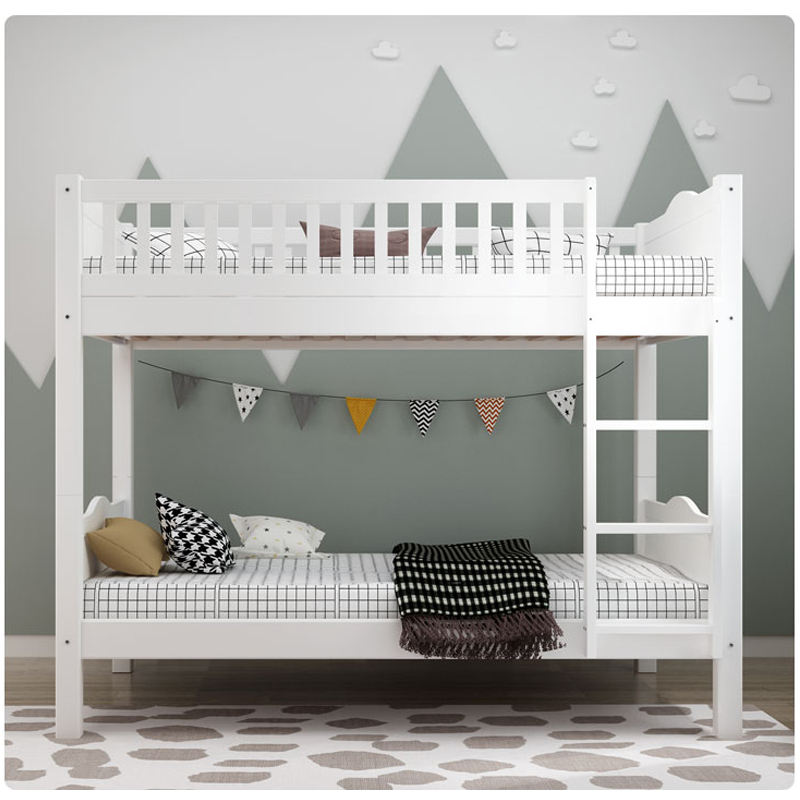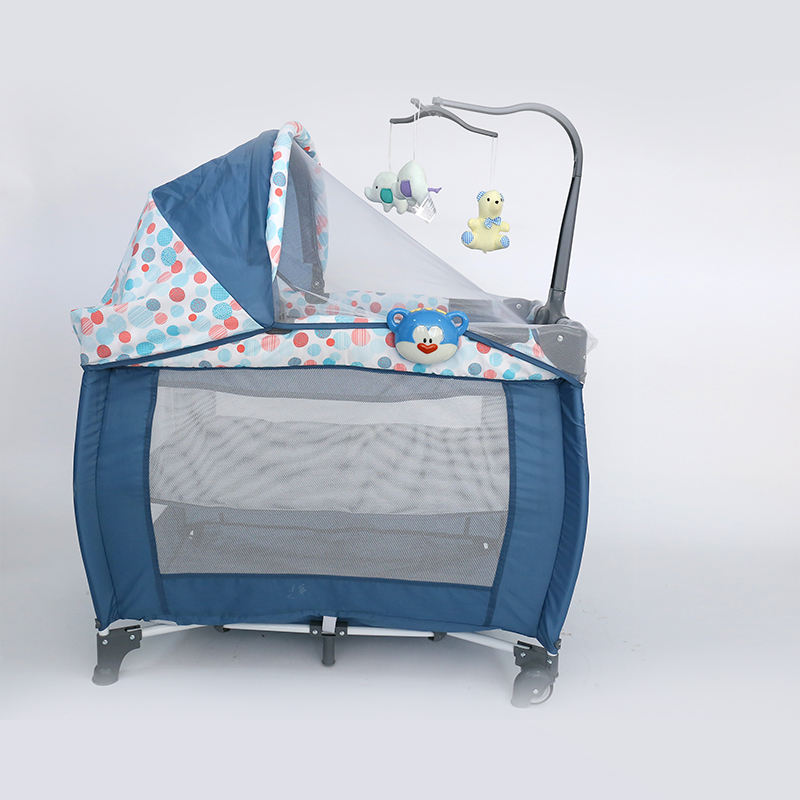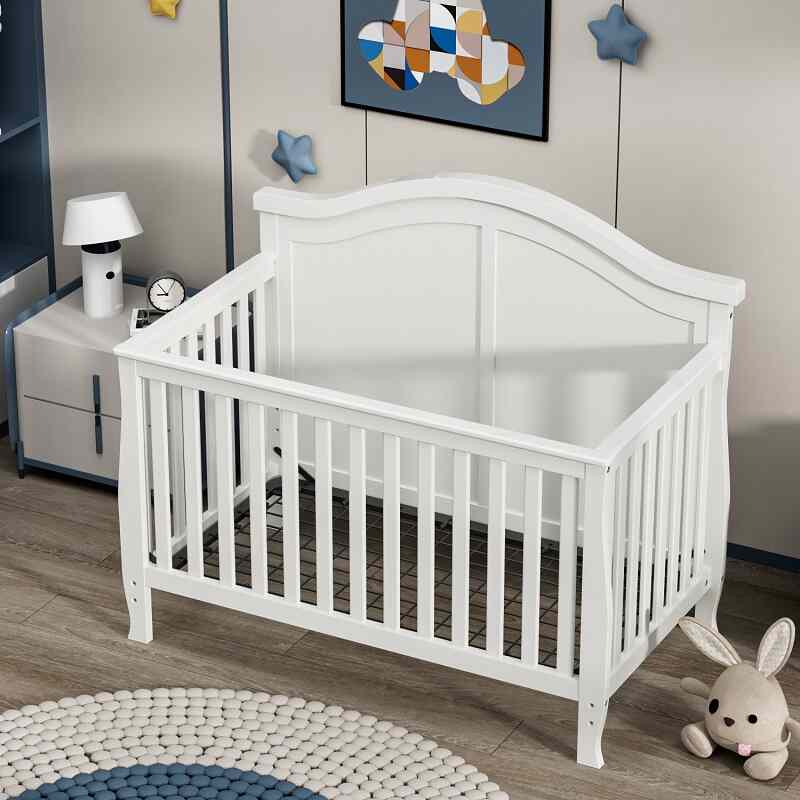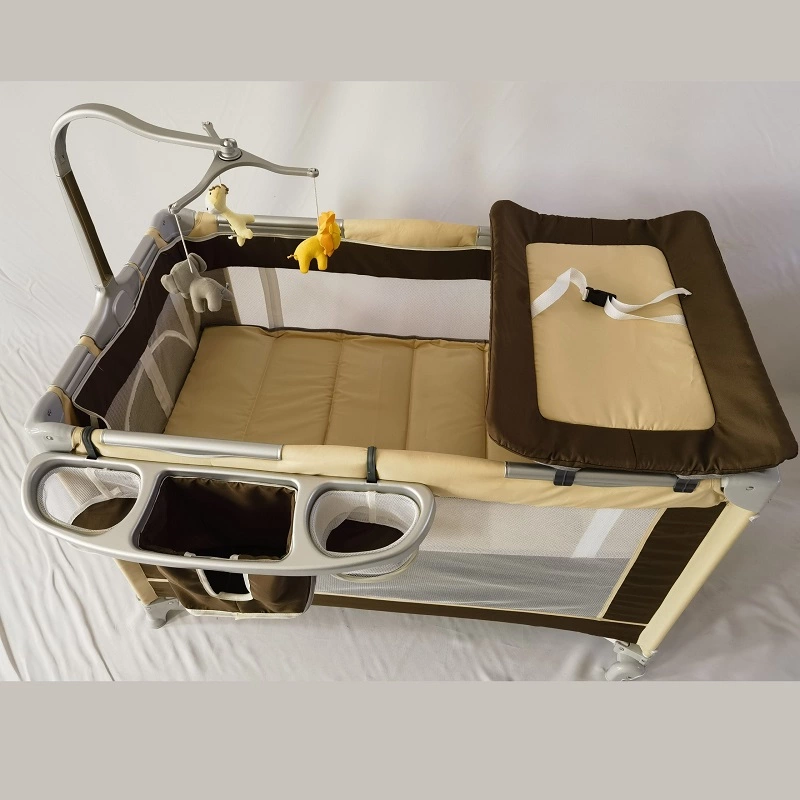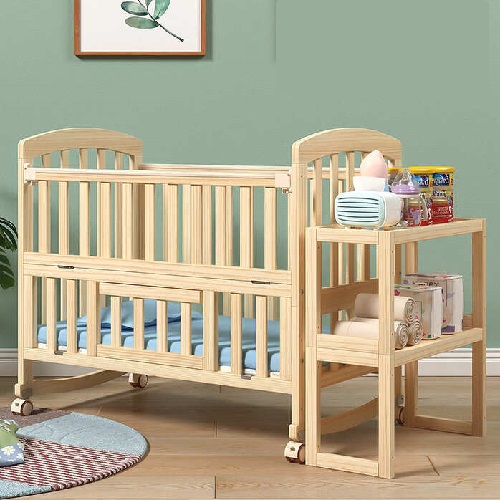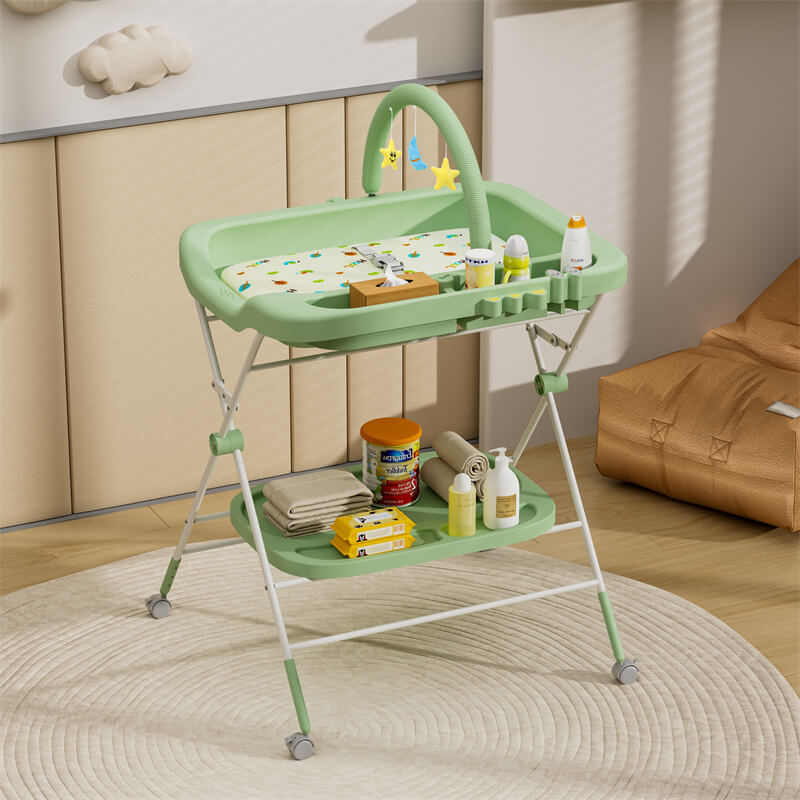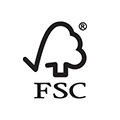Navigating the world of móveis infantis can be a whirlwind of decisions, styles, and safety considerations. Among these, bunk beds stand out as a space-saving solution. But, as with any furniture designed for children, questions and concerns naturally arise. This comprehensive guide aims to explore every facet of choosing, using, and enjoying bunk beds while ensuring your kids’ safety and maximizing room space and style.
Are Bunk Beds Dangerous for Kids?
This concern is valid, given the height of bunk beds and the potential for falls or injuries. Nonetheless, with advancements in design and safety standards, many of these risks have been significantly mitigated.
In today’s market, fabricantes de beliches are required to adhere to strict guidelines aimed at ensuring the safety of bunk beds. These guidelines encompass various aspects of design and construction, with a focus on minimizing potential hazards. Key features such as guardrails, sturdy ladders, and proper mattress support have become standard in modern bunk bed design. Guardrails, in particular, play a crucial role in preventing accidental falls during sleep, providing a protective barrier for the sleeper on the upper bunk. Sturdy ladders offer a secure means of accessing the top bunk, reducing the risk of slips or falls during ascent or descent. Additionally, ensuring adequate mattress support helps maintain stability and structural integrity, further enhancing safety.
Despite these advancements, supervision and education are key. Teaching children the proper way, such as no roughhousing on the upper bunk and always using the ladder for getting up and down, is essential.
While acknowledging the potential risks associated with bunk beds, it’s evident that with proper design, adherence to safety standards, and responsible usage, these beds can provide a comfortable and safe sleeping environment for children.
Tips for the Safe Use of Bunk Beds
Choose a sturdy bunk bed: Ensure that the bed is well-constructed and meets safety standards. Check for any loose or wobbly parts before allowing children to use it.
Guarda-corpos: Make sure that has guardrails on the top bunk to prevent falls. The guardrails should be secure and should leave no gaps where a child’s head could become trapped.
Age appropriateness: It’s essential to consider the maturity and developmental stage of the children who will be using the bunk bed. Younger children might not yet possess the necessary responsibility to safely sleep in a top bunk.
No jumping: Discourage children from jumping on the bunk beds, as this can lead to injuries or damage to the bed frame.
No rough play: Teach children to avoid rough play on or around the beds, as this can increase the risk of falls or other accidents.
Posicionamento: Place the bunk bed away from ceiling fans, light fixtures, or any other hazards that could pose a danger to children sleeping in the top bunk.
Nightlights: Consider using nightlights near the bed to provide visibility during the night, especially for children sleeping in the top bunk who may need to navigate the ladder in the dark.
Getting in and out of the top bunk safely:
- Always use the ladder provided to climb up to the top bunk. Discourage children from climbing or jumping onto the top bunk from other furniture or surfaces.
- When climbing up or down the ladder, children should face the ladder and hold onto the rungs with both hands. This provides better stability and reduces the risk of falling.
- Teach children to wait for the person ahead of them to climb up or down the ladder before starting their ascent or descent.
- Discourage children from playing or roughhousing on the ladder.
- Remind children to watch their steps and be mindful of their footing when climbing up or down the ladder. Encourage them to use caution, especially if the ladder is slippery or if they’re wearing socks.
- Emphasize the importance of using the ladder to descend from the top bunk rather than jumping off.
- Ensure that no obstacles or clutter around the ladder could cause tripping or obstruct safe passage.
Common Materials Used in Bunk Bed Construction
Solid Wood Bunk Beds
- Durability: High-quality hardwoods such as oak, maple, or cherry can withstand years of use without showing signs of wear and tear.
- Aesthetics: It offers a warm, traditional look. They come in a wide range of finishes, from light to dark stains, allowing for customization to match the room’s aesthetic.
- Safety: It typically has rounded edges and smooth surfaces, which can reduce the risk of injury from accidental bumps or falls.
- Cost: Wood bunk beds tend to be more expensive than metal bunk beds due to the cost of materials and craftsmanship.
- Weight: Wood bunk beds are generally heavier than metal bunk beds, which can make them more challenging to move or reposition. However, this weight can also contribute to their stability and sturdiness.
Metal Bunk Beds
- Durability: They are often constructed from steel or wrought iron, which can withstand heavy use and are less prone to warping or cracking compared to wood.
- Cost: Metal bunk beds are generally more affordable than wood bunk beds, making them a budget-friendly option for many families.
- Weight: Metal bunk beds are lighter and more portable than wood bunk beds, making them easier to assemble, disassemble, or move when needed. This can be advantageous for families who anticipate frequent relocation or rearrangement of furniture.
- Maintenance: Metal bunk beds are relatively low-maintenance and easy to clean with a damp cloth. They are less susceptible to stains, scratches, or water damage compared to wood bunk beds.
Engineered Wood Bunk Bed
- Material Composition: Utilize a combination of wood products, such as particleboard, MDF (medium-density fiberboard), or plywood, bound together with adhesive and compressed under high pressure, offers an economical alternative to solid wood or metal.
- Durability: While these materials can emulate the look of real wood at a lower cost, their durability and weight capacity might not match up to solid wood or metal options.
- Aesthetics: Can mimic the appearance of solid wood but may lack the natural grain and texture.
- Weight: Typically lighter than solid wood bunk beds but heavier than metal bunk beds. They offer a balance between stability and portability.
- Cost: Tend to be more budget-friendly than solid wood bunk beds.
If it is used for daily home decor and has a certain budget, prioritizing wooden bunk beds is highly recommended, which are suitable for long-term use by families and individuals. It exudes a sense of warmth and charm and fits in perfectly with traditional home decor. One of the standout features of wooden bunk beds is the unparalleled comfort they provide. The natural grain and texture of wood create an inviting atmosphere, fostering a cozy ambiance that promotes relaxation and restful sleep.
Quanto peso um beliche pode suportar?
On average, a standard bunk bed can support about 150-200 pounds on the top bunk and more on the bottom bunk. It’s important to note that this includes both the sleeper’s weight and the weight of the mattress.
For families with older children or teens, it may be wise to consider bunk beds designed to hold more weight. Some models are specifically crafted to accommodate adults, with weight capacities reaching up to 400 pounds for the top bunk. Checking the manufacturer’s specifications before purchase can provide clarity and ensure the bed’s suitability for its intended users.
What Are the Bunk Bed Sizes?
| Cama de solteiro sobre beliche de solteiro | This is one of the most popular sizes, featuring two twin-sized beds stacked on top of each other. | 75 in × 39in |
| Cama de solteiro sobre beliche completo | The top bunk is a twin-sized bed, while the bottom bunk is a full-sized bed. | Twin bed: 75 in × 39 in Full bed: 75 in × 54 in |
| Beliche completo sobre beliche completo | Features two full-sized beds stacked on top of each other | 75 in × 54 in |
| Cama de solteiro sobre beliche queen | The top bunk is a twin-sized bed, while the bottom bunk is a queen-sized bed. | Twin bed: 75 in × 39 inQueen bed: 80 in × 60 in |
| Custom Sizes | Some bunk bed manufacturers offer custom sizes to meet specific space requirements or user preferences. | Such as twin XL over twin XL, full XL over full XL, or other combinations tailored to individual needs. |
How to Pick the Right Bunk Bed for Your Child
Measure the Room: Start by measuring the available space in the room where the bunk bed will be placed. Consider factors such as ceiling height, floor space, and any obstructions such as windows or doors.
Consider the Child’s Age and Needs: Younger children may prefer lower bunk beds with easy access, while older children might enjoy the novelty of sleeping in a top bunk. Consider whether your child will need additional safety features such as guardrails or a staircase with handrails.
Choose the Right Size: Select a bunk bed size that suits your child’s needs and the available space. Common sizes include twin over twin, twin over full, and full over full. Keep in mind that larger bunk beds may require more room to accommodate both the bed frame and movement around it.
Evaluate Safety Features: Look for features such as sturdy guardrails on the top bunk, a secure ladder or staircase for accessing the top bunk, and rounded edges to minimize the risk of injuries. Ensure that the bunk bed meets safety standards set by organizations such as ASTM International or the Consumer Product Safety Commission (CPSC).
Consider Storage and Additional Features: Some bunk beds come with built-in storage drawers, shelves, or trundle beds, which can be useful for maximizing space in a child’s room.
Test Stability and Quality: Before making a purchase, physically inspect the bunk bed. Shake the bed lightly to check for any wobbling or instability.
What Are the Common Bunk Bed Styles?
Beliche com escrivaninha
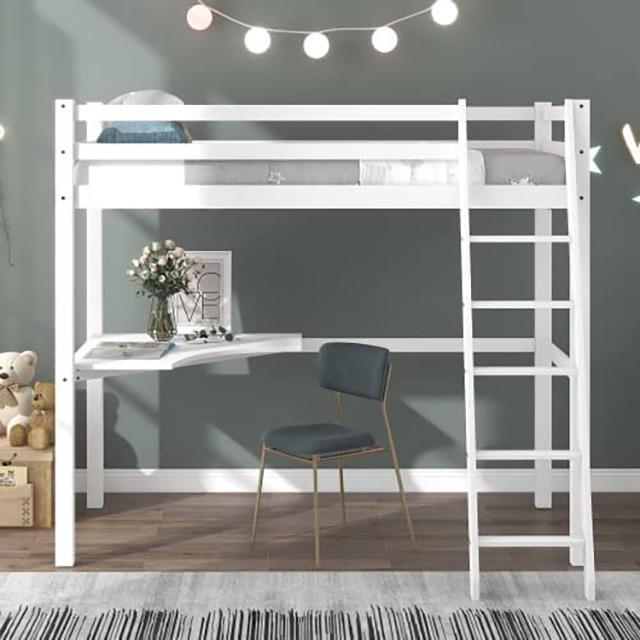
Bunk beds with desks feature a loft-style design where the top bunk is elevated, providing space underneath for a built-in desk. This configuration maximizes floor space in smaller rooms by combining two essential pieces of furniture into one. The desk area typically includes a desktop surface, storage shelves or drawers, and sometimes a built-in ladder or staircase for access to the top bunk.
Application Scenarios: Bunk beds with desks are ideal for children’s bedrooms, teen rooms, or dormitories where space is limited. These beds are especially suitable for students who need a quiet and organized space for homework, studying, or creative activities.
Precautions: When installing a bunk bed with a desk, ensure that the desk area is sturdy and securely attached to the bed frame. It’s essential to consider the height of the ceiling and the placement of lighting fixtures to prevent any obstructions above the desk area.
Children’s Bunk Beds with Slide
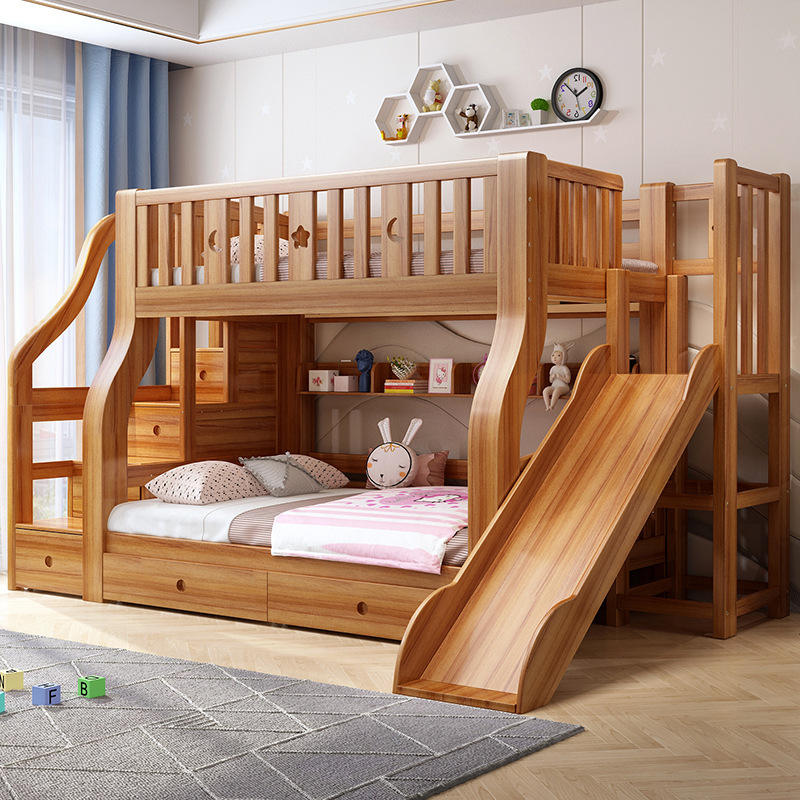
This is a bunk bed that will make kids squeal with excitement. Which kid wouldn’t want to have his or her slide in the room? They can freely arrange their playtime, and they can also invite their best friends to play together. These beds typically feature an attached slide that allows children to safely and easily exit the top bunk. The slide is securely integrated into the bed frame and may have a ladder or staircase for access to the top bunk. These beds often come in playful designs and vibrant colors to appeal to children’s imaginations.
Application Scenarios: Bunk beds with slides are perfect for children’s bedrooms or playrooms. These beds are particularly popular in households with younger children who may be transitioning from a crib to a bed, as the slide provides a fun incentive for them to sleep in their own space.
Precautions: When installing a bunk bed with a slide, ensure that the slide is securely attached to the bed frame and meets safety standards. It’s essential to provide adequate clearance around the slide to prevent accidents and ensure safe use. Supervise younger children when using the slide to prevent rough play or accidents, and remind them to use it safely and responsibly.
Bunk Bed with Storage Stairs
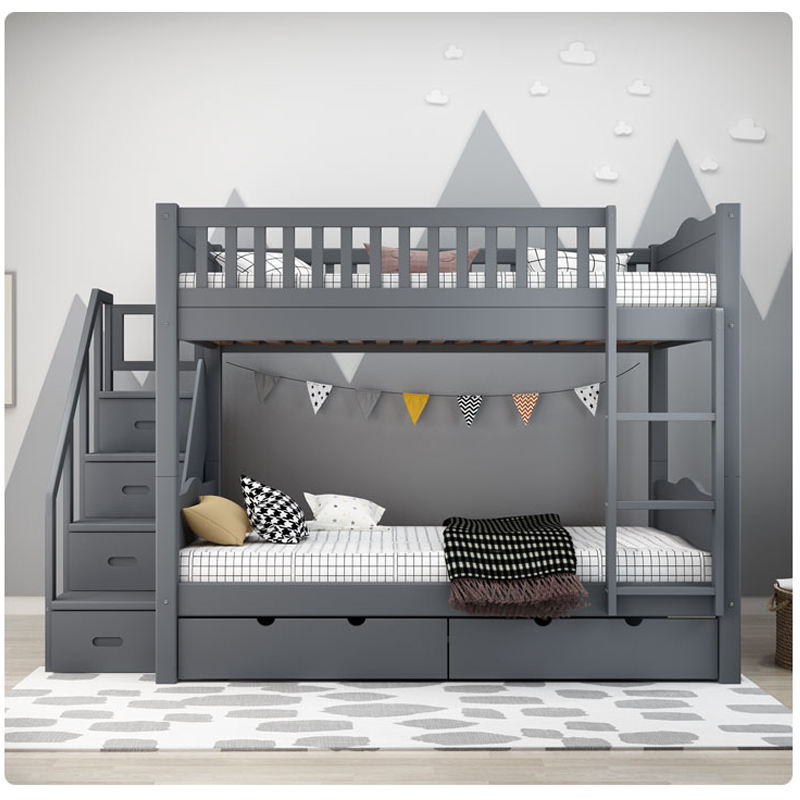
This is a very popular style among parents and children and is the first choice for many families. Bunk beds with storage stairs incorporate storage drawers or compartments into the staircase leading to the top bunk. Each step of the staircase serves as a drawer or cubby, providing convenient storage space for clothing, toys, books, or other belongings. This design maximizes vertical space and eliminates the need for separate storage furniture in the room.
Application Scenarios: Bunk beds with storage stairs are ideal for children’s bedrooms or shared spaces where storage is limited. They provide multiple storage spaces while also serving as a safe and easy-to-use access point to the top bunk.
Precautions: When installing a bunk bed with storage stairs, ensure that the staircase is securely attached to the bed frame and meets safety standards. Regularly check the drawers or compartments for any loose or sharp objects that could pose a safety risk.
Beliche Triplo
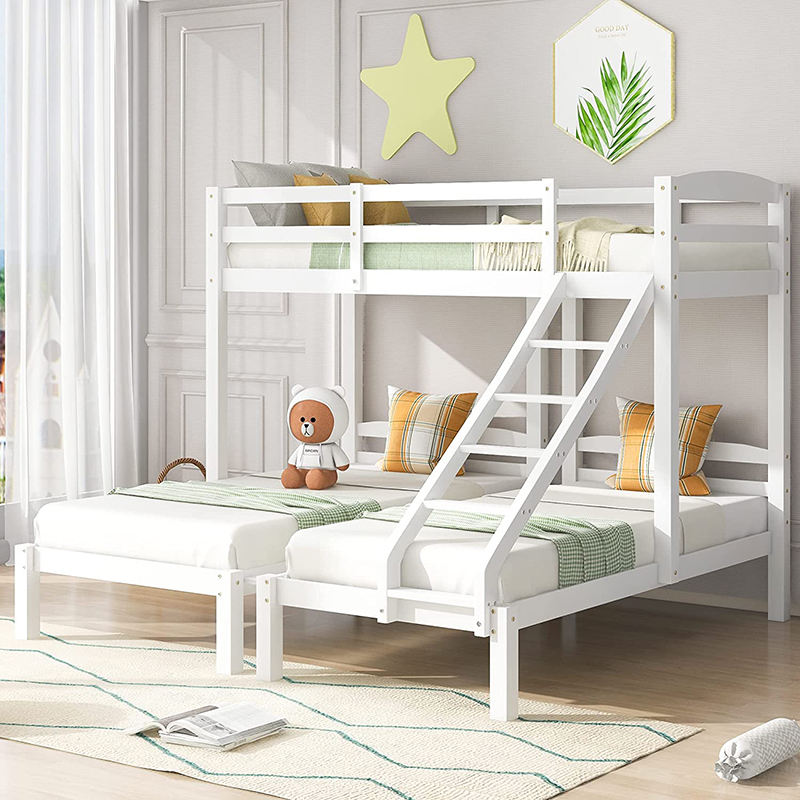
Don’t be surprised when you hear about a three-person bunk bed. It is not as narrow and oppressive as you think. Based on modern design, the three-person double bed still allows people to have a comfortable space to sleep. A triple bunk bed features three sleeping surfaces stacked on top of each other. These beds typically consist of a traditional bunk bed configuration with an additional third bunk either perpendicular or parallel to the bottom bunk. The design may vary, with the top and middle bunks being twin-sized and the bottom bunk being full-sized, or all three bunks may be the same size.
Application Scenarios: Triple bunk beds are commonly used in children’s bedrooms, dormitories, or vacation homes where space is limited, and multiple sleepers need to be accommodated. They are especially popular for siblings sharing a room or for families with frequent guests. Triple bunk beds are also practical for maximizing sleeping capacity in vacation rentals or dormitory-style accommodations.
Precautions: When installing a triple bunk bed, ensure that it is securely anchored to the wall and meets safety standards for weight capacity and structural integrity.
L Shaped Bunk Beds

L-shaped bunk beds feature two beds arranged in an L-shaped configuration, with one bed positioned perpendicular to the other. This design maximizes floor space by utilizing the corner of the room and provides a unique layout that can be more space-efficient and versatile than traditional bunk beds. The top and bottom bunks may be the same size or different sizes, depending on the specific design.
Application Scenarios: They are commonly used in children’s bedrooms, dormitories, or guest rooms where space is limited. They can be positioned against two walls or in a corner to optimize space usage.
Low Bunk Bed
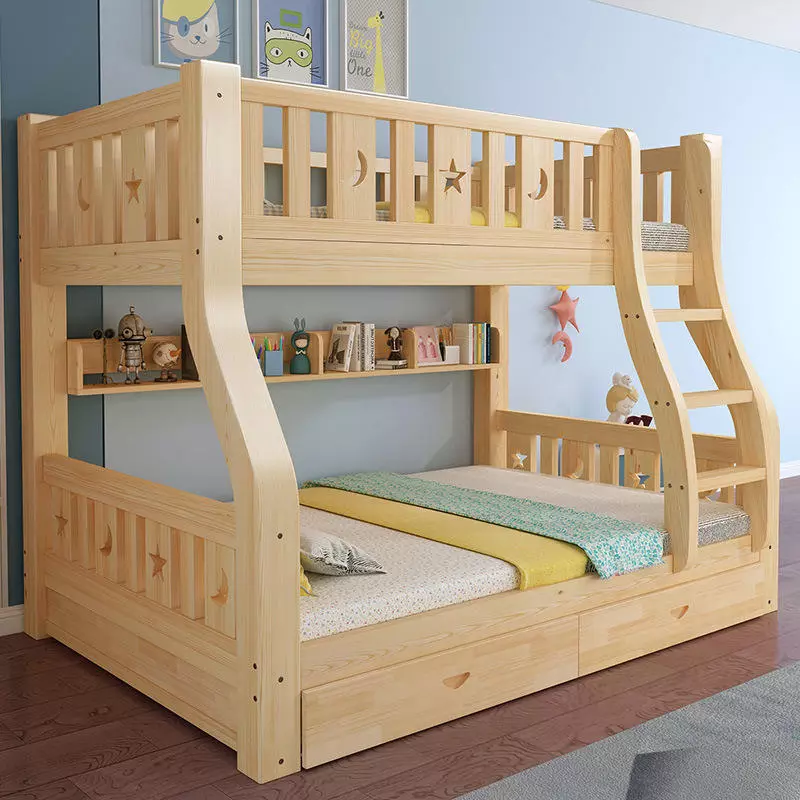
A low bunk bed is designed with both the top and bottom bunks positioned closer to the ground compared to traditional bunk beds. This design is particularly suitable for younger children or rooms with low ceilings. Low bunk beds typically feature a shorter height between the bunks, making it easier for children to access both sleeping surfaces safely. This type of bed is also very Montessori style. The low height promotes independence and freedom of movement, empowering children to take control of their bedtime routine.
Application Scenarios: It is ideal for children’s bedrooms, preschools, or daycare facilities where safety and accessibility are a priority. Low bunk beds are also practical for rooms with low ceilings or sloped ceilings where a traditional bunk bed may not fit comfortably.
Convertible Bunk Beds
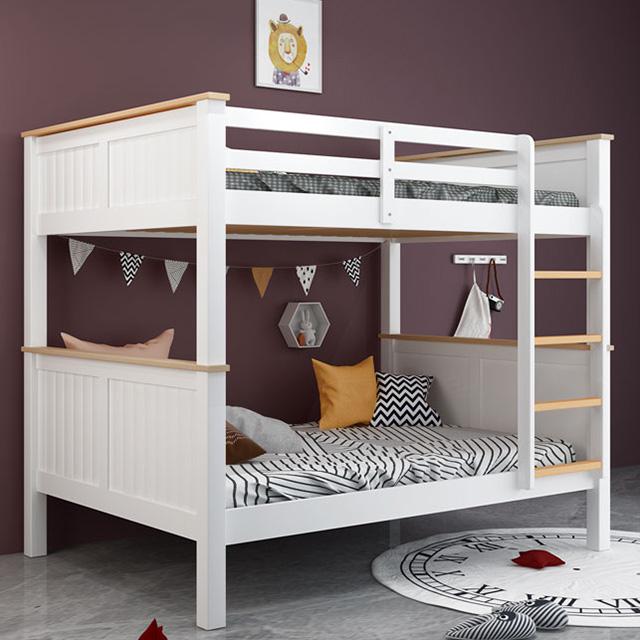
If you don’t plan on letting your child sleep in a bunk bed all the time, or if you don’t like the same furniture, then this bed may satisfy you. These bunk beds can be transformed or reconfigured into different configurations to suit changing needs or preferences. Examples of convertible features include the ability to separate the bunk beds into two individual beds, convert the top bunk into a loft bed, or incorporate additional storage or seating options.
Application Scenarios: Convertible bunk beds are ideal for children’s bedrooms, guest rooms, or small living spaces where space-saving solutions are needed.
Bunk Bed with Trundle

When a guest suddenly comes to your home but there is no extra room, you can use a little “magic” to create a bed for the guest to rest temporarily. A trundle bunk bed combines a traditional bunk bed with a trundle bed, providing an additional sleeping surface that can be stored underneath the bottom bunk when not in use. The trundle bed is typically on casters or wheels for easy maneuverability and can be pulled out when needed to accommodate an extra sleeper. Trundle bunk beds are available in various configurations, including twin over twin, twin over full, or full over full.
Application Scenarios: Trundle bunk beds are particularly popular for sleepovers or family gatherings, allowing for convenient and comfortable sleeping arrangements without taking up additional floor space during the day.
Precautions: When using a trundle bunk bed, ensure that the trundle bed is securely locked in place when not in use to prevent it from accidentally rolling out. It’s essential to consider the weight capacity of the trundle bed and ensure that it can safely support the intended sleeper(s).
Ideas for Integrating Bunk Beds into Overall Room Design
Theme-based Design: Such as a nautical, space, or jungle theme. Use themed bedding, wall decals, and accessories to tie the bunk beds into the theme.
Accent Lighting: Install LED strip lighting under the bunk beds to create a cozy ambiance. Use wall-mounted reading lights or pendant lamps above each bunk for individualized illumination.
Functional Decor: Hang wall organizers or cork boards near the beds for displaying artwork, photos, or schedules. Incorporate a small desk or study area underneath one of the bunks for homework or creative activities.
Textured Walls: Apply textured wallpaper or use decorative paint techniques to add visual interest to the walls behind the bunk beds. Consider a chalkboard or magnetic paint finish for one wall to encourage creativity and interaction.
Cobertura ou tenda: Install a canopy or tent over the top bunk to create a private and whimsical sleeping space.
Is a Custom Bunk Bed Necessary?
Many manufacturers now offer custom bunk bed services to meet customers’ special needs and preferences. If you have the following situations, it is still necessary to choose customized services:
1. If your room has unique dimensions, angles, or architectural features that don’t accommodate standard bunk bed sizes, customization may be necessary to ensure a perfect fit and optimal use of space.
2. If you require specific features or functionalities not commonly found in standard bunk beds, such as built-in storage solutions, integrated study areas, or safety modifications for children with special needs, customization allows you to tailor the bed to meet these unique needs.
3. If you have a unique idea for a bunk bed and want one that exactly matches your heart’s desire, then don’t hesitate, customization options can do just that.
A Bolder Idea: Built-In Bunk Beds
If you have a special fondness for bunk beds and plan to make them a part of your and your children’s lives for a long time, then consider a built-in bunk bed option. Built-in bunk beds can be a fantastic and bold design choice, especially for rooms with limited space or unconventional layouts.
Built-in bunk beds are bunk beds that are designed to be integrated directly into the structure of a room. Unlike freestanding bunk beds, which can be moved or relocated, built-in bunk beds are fixed in place and typically constructed as part of the room’s architecture or custom-built to fit within specific dimensions.
Because built-in bunk beds are anchored directly to the wall or built into the room’s structure, they are typically more stable and secure than freestanding bunk beds. This provides added safety and peace of mind, especially for families with children.
Built-in bunk beds create a cohesive and integrated look in the room, blending with the overall decor and architecture. With built-in bunk beds, you have endless customization options to tailor the design to your exact specifications. From choosing the materials and finishes to incorporating built-in storage, lighting, or unique features, you can create a truly personalized and functional sleeping solution.
Conclusão
Toddler bunk beds are a versatile and practical solution for families looking to optimize space in kids’ bedrooms. Many children enjoy the novelty of sleeping in bunk beds and may even view them as a fun and exciting aspect of their bedroom decor. By choosing a well-designed and safe bunk bed, parents can create a comfortable and inviting bedroom environment.
Artigos relacionados recomendados:


